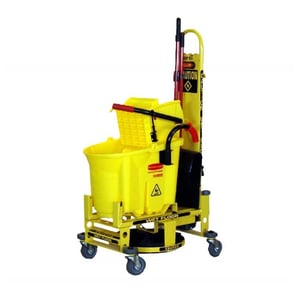Chances are you’ve used a mop or similar tool to clean up household spills and freshen your floors. However, commercial settings and large buildings call for a different type of mop.
What are some of the common mop types you’ll find in a commercial setting and how do you use them to boost efficiency of cleaning your floors?
 Types of Mops
Types of Mops
Generally, there are 5 types of mops that can be used in both household and commercial settings.
Flat mops are one of the most common types of mops. They have a flat head with a disposable or reusable pad. They are great for quick cleaning and getting into deep corners and crevices of the floor.
Steam mops are crucial tools for commercial buildings. Steam mops often have a refillable tank for water, which then turns to steam and sprays through a reusable or disposable mopping pad. They both wash and disinfect at the same time, and they are great for removing scuff marks and caked-on grime.
There are also sponge mops, which are made of sponge and then can be wrung out with an attached wringer. There are string (rag) mops and strip mops, but they can often breed bacteria and start to smell after just a few uses. Larger organizations tend to avoid string and strip mops because, although they get the job done, the tools themselves take extra work to clean and take care of.
Flat mops and steam mops are traditionally recommended for larger buildings as they work wonders to get the job done with the littlest amount of manpower. They also have minimal upkeep, since the mop pads are disposable or reusable.
Types of Mop Pads
Some mop heads are easier to use than others. We prefer mops with an EZ attachment system, like our Fas-Trak EZ Applicator Pads. These take no time at all to snap into place, saving time and boosting your maintenance staff’s productivity.
Different mop heads also can be used for different purposes. For example, stripper pads or scuff pads are used to remove scuff marks and save time by reducing the length of the buffing cycle. Microfiber pads can help remove dust, minimize labor, and save money on cleaning solutions.

Mop Mobility
So, you know the type of mop and the relevant, refillable mop pads that you’ll need for your space. But how do you know which mop to choose? There are three other major aspects to consider with regards to your mop’s mobility and ability to get the job done:
Does the mop head pivot, or is it stationary?
For large, open spaces, a large stationary mop head can work to ensure a lot of space is covered with less work. However, for tighter office spaces with a lot of walls and furniture, you want to ensure the mop head can pivot and fit around without added effort by the worker.
Is it electric? Is it automatic and pressurized?
For commercial buildings with daily mopping, an electric mop can make life much simpler and easier for the maintenance crew. However, for general clean ups and spills, an electric mop may get in the way of convenience and mobility. This also begs the question: how easy is the mop to hold versus how powerful is it?
Does the head have to be dunked in a solution, or is there a tank on the mop?
Traditional mops are “dunked” in mop buckets of water and cleaning solutions. These save money on cleansing solutions, as dunkable mops are diluted in water and that same water is reused throughout one cleaning session. However, it is oftentimes more convenient and sanitary to use a refillable mop tank or automated spray system so as to avoid the spread of germs.
Check out Floorcare’s mop and bucket systems to find the perfect mop and pad for all your swabbing, cleaning needs!



0 comments